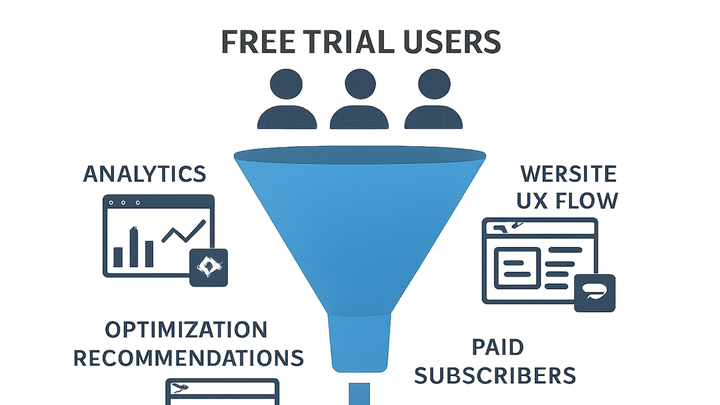Published on 2025-06-29T20:27:01Z
What is Trial-to-Paid Conversion? Definition and Examples
Trial-to-Paid Conversion refers to the percentage of users who move from a free trial period to a paid subscription within a SaaS or online product. This metric is a key indicator of how well a website converts interested prospects into revenue-generating customers. In CRO (Conversion Rate Optimization), UX (User Experience), and SEO (Search Engine Optimization), improving this rate directly impacts monthly recurring revenue (MRR), customer acquisition cost (CAC), and overall business growth. Factors influencing trial-to-paid conversion include onboarding flow clarity, perceived product value, pricing strategy, and engagement touchpoints like email campaigns and in-app guidance. Tools like Prevue.me can provide actionable critiques across CRO, lead generation, UX, SEO, and accessibility to uncover friction points and optimize the trial experience.
Trial-to-paid conversion
Percentage of trial users who upgrade to paid, reflecting user engagement and revenue potential.
Why Trial-to-Paid Conversion Matters
Understanding why this metric is crucial for sustainable growth and the roles it plays in CRO, UX, and SEO.
-
Revenue growth
Each successful trial conversion directly increases monthly recurring revenue and shortens CAC payback periods.
- Monthly recurring revenue (mrr):
Paying users contribute to predictable revenue streams, enabling better forecasting.
- Customer acquisition cost (cac):
Higher conversion reduces the average cost to acquire a customer over time.
- Monthly recurring revenue (mrr):
-
Product-market fit validation
A strong conversion rate signals that your offering resonates with target users and solves real problems.
-
User engagement indicator
Shows how effectively the onboarding experience guides users to ‘aha’ moments and core features.
Key Metrics and Benchmarks
Monitor these sub-metrics to diagnose trial-to-paid performance and compare against industry standards.
-
Trial activation rate
Percentage of sign-ups who actually start the trial, indicating onboarding clarity.
-
Trial conversion rate
Core metric: trial users who become paying customers within a defined period.
-
Average time to conversion
Average days between trial start and payment, highlighting onboarding efficiency.
Strategies to Improve Trial-to-Paid Conversion
Proven tactics to optimize the user journey, reduce friction, and showcase product value quickly.
-
Optimize onboarding experience
Streamline sign-up flows and guide users to key features and quick wins.
- Clear value proposition:
Communicate core benefits and next steps immediately upon trial start.
- Interactive tutorials:
Offer in-app tours or tooltips to help users complete critical tasks.
- Clear value proposition:
-
Implement personalized email campaigns
Use targeted nurture sequences to re-engage trial users based on behavior.
- Behavioral triggers:
Send messages when users reach milestones or show signs of churn.
- Segmentation:
Tailor content to user roles, use cases, or feature interests.
- Behavioral triggers:
-
Leverage social proof and case studies
Highlight customer success stories and testimonials to build trust.
-
A/b test pricing and trial length
Experiment with different pricing tiers or trial durations to find the optimal balance.
Example: Using Prevue.me to Boost Conversion
How prevue.me’s actionable critiques help identify friction points and optimize for higher trial-to-paid rates.
-
Automated ux critiques
Detect usability issues in the trial flow, such as confusing navigation or form friction.
-
Seo and accessibility recommendations
Improve page speed, metadata, and accessibility to reduce drop-offs during trial sign-up.
-
Cro-focused lead generation insights
Identify where potential users abandon and get suggestions for stronger CTAs and landing pages.
-
Continuous monitoring and reporting
Use prevue.me dashboards to track trial metrics, run experiments, and measure impact over time.
